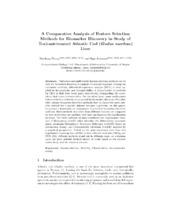A Comparative Analysis of Feature Selection Methods for Biomarker Discovery in Study of Toxicant-Treated Atlantic Cod (Gadus Morhua) Liver
Chapter, Peer reviewed
Accepted version

Åpne
Permanent lenke
https://hdl.handle.net/1956/21642Utgivelsesdato
2019Metadata
Vis full innførselSamlinger
Originalversjon
In: Bach K, Ruocco M. Nordic Artificial Intelligence Research and Development. NAIS 2019. Communications in Computer and Information Science, 1056, 114-123. https://doi.org/10.1007/978-3-030-35664-4Sammendrag
Univariate and multivariate feature selection methods can be used for biomarker discovery in analysis of toxicant exposure. Among the univariate methods, differential expression analysis (DEA) is often applied for its simplicity and interpretability. A characteristic of methods for DEA is that they treat genes individually, disregarding the correlation that exists between them. On the other hand, some multivariate feature selection methods are proposed for biomarker discovery. Provided with various biomarker discovery methods, how to choose the most suitable method for a specific dataset becomes a problem. In this paper, we present a framework for comparison of potential biomarker discovery methods: three methods that stem from different theories are compared by how stable they are and how well they can improve the classification accuracy. The three methods we have considered are: Significance Analysis of Microarrays (SAM) which identifies the differentially expressed genes; minimum Redundancy Maximum Relevance (mRMR) based on information theory; and Characteristic Direction (GeoDE) inspired by a graphical perspective. Tested on the gene expression data from two experiments exposing the cod fish to two different toxicants (MeHg and PCB 153), different methods stand out in different cases, so a decision upon the most suitable method should be made based on the dataset under study and the research interest.